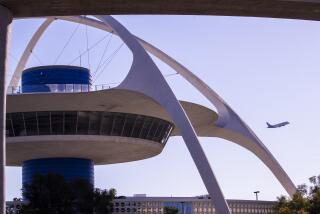FAA looks at oxygen mask concerns
- Share via
The Federal Aviation Administration is reviewing the reported failures of dozens of oxygen masks aboard an American Airlines flight that made an emergency landing last week at Los Angeles International Airport.
FAA officials said Monday that they were looking into concerns that some masks for passengers did not deploy during the incident while others failed to provide oxygen.
“We take reports like this very seriously,” said Ian Gregor, an FAA spokesman. “The FAA is working closely with American to determine what the problems are, why they happened, and to make sure the problems are fixed.”
American Airlines Flight 31 had just taken off from LAX about 9 a.m. on Aug. 5 when the pilot reported smoke in the cabin. The Boeing 757, which was en route to Honolulu, immediately returned to LAX and made an emergency landing.
Airport officials said 188 passengers and seven crew members were evacuated using the aircraft’s emergency chutes -- a rare occurrence. Eight people suffered minor injuries.
American Airlines blamed the incident on hot oil that leaked from a compressor for one of the plane’s two jet engines. It produced a strong odor and some haze in the passenger cabin. Tim Wagner, an airline spokesman, said the problem turned out to be minor.
Wagner said American was reviewing the emergency landing and whether the aircraft’s oxygen masks worked properly. He said the masks are specifically designed to supply oxygen to passengers and crew members during the loss of cabin pressure at higher altitudes.
“They are not meant to be used in a fire or smoke situation,” Wagner said.
Federal officials say emergency oxygen masks are supposed to work whether they are automatically deployed during depressurization or manually activated by the flight crew, as was the case with Flight 31.
The FAA has been concerned for some time about oxygen mask failures aboard Boeing 757s and 737s -- aircraft that are popular with foreign and domestic airlines.
In May 2007, the agency issued an air worthiness directive ordering carriers to inspect oxygen masks on those planes and correct any problems by 2012. The directive affects about 815 of the two types of jetliners that fly routes in the United States.
FAA officials issued the order after receiving information that oxygen generators had failed during in-flight depressurization. The agency blamed components that had fractured between the oxygen masks and the release pins that activate the flow of air.
During its review of the emergency landing, Wagner said American would consider the decision by the flight crew to evacuate passengers using the chutes.
Questions have been raised in news reports about the necessity of activating the slides for what turned out to be a relatively minor problem.
Wagner said that American flight attendants receive safety training and have the authority to activate the chutes if they think it is necessary. Gregor said the decision to deploy the slides did not violate FAA regulations.
Air traffic controllers at LAX were concerned that the American Airlines pilot did not notify the tower that emergency chutes were going to be deployed, said Michael Foote, a local representative of the National Air Traffic Controllers Assn.
Foote said controllers are responsible for directing aircraft as they taxi to and from terminals. Advance notice from the American flight, he said, would have made it easier for controllers to handle the situation.
--
More to Read
Inside the business of entertainment
The Wide Shot brings you news, analysis and insights on everything from streaming wars to production — and what it all means for the future.
You may occasionally receive promotional content from the Los Angeles Times.











